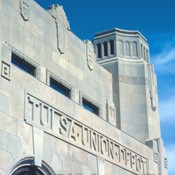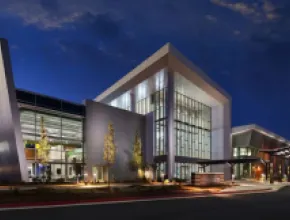Oklahoma City and Tulsa are Oklahoma’s two largest cities and complement one another nicely.
Although Oklahoma City is the state capital and the seat of government, visitors will experience the city’s Western heritage via museums, cattle auctions and a general can-do attitude. Tulsa is slightly smaller but has used its oil-derived wealth to help turn the city into Oklahoma’s arts and culture center, with internationally known museums, ballet companies and even opera.
Oklahoma will commemorate the centennial of its statehood in 2007 with a series of events, particularly the Oklahoma Centennial Exposition in Oklahoma City Sept. 13-23 and the Spirit of Oklahoma Music Awards in Tulsa Nov. 27.
Oklahoma City
Oklahoma City—OKC for short—has a half-million people and anchors a metropolitan area of 1.1 million and counting. Sudden growth spurts are not uncommon here considering Oklahoma City’s unique history: It had a population of zero until one fine spring day in 1889, when thousands of homesteaders showed up on previously “unassigned” lands and created a tent metropolis overnight.
Oklahoma City was already the state’s commercial hub by statehood in 1907 and became its official capital shortly thereafter. The discovery of oil here in 1928 began a mineral boom that continues to the present day—although the oil well on the grounds of the Oklahoma State Capitol has long since been taken down.
The Depression hit Oklahoma City hard, but since World War II it has become an interstate transport hub, it completed the long-unfinished Oklahoma State Capitol dome, it welcomed a strong military presence at Tinker Air Force Base in nearby Midwest City, and it endured the 1995 terrorist bombing of the Alfred P. Murrah Federal Building.
Today, Oklahoma City’s downtown thrives, thanks to the Metropolitan Area Projects (MAPS), a sales tax-funded series of capital improvements that have resulted in a new ballpark, library and indoor arena, as well as fairground renovations and waterfront improvements on the North Canadian River. The projects, totaling more than $1 billion, have helped boost the city’s appeal among groups, says Alan Sims, director of convention sales and services for the Oklahoma City CVB.
“One of the key components of MAPS was to make the city more attractive to conventions,” he says. “So now all of those projects have been completed, and it’s had a significant impact on how the city is perceived.”
Sims notes that the city is currently planning the next wave of MAPS, which will include moving Interstate 44 a dozen blocks south of downtown to improve the core area’s aesthetics and pedestrian-friendliness.
As Oklahoma’s capital, the city has a big association market since many statewide associations are headquartered here, Sims says.
Oklahoma City’s major meetings venue is the Cox Business Services Convention Center, which totals about 1 million square feet, including more than 100,000 square feet of exhibit space and a 15,000-seat arena that adds another 35,000 square feet of flexible floor space. Directly across the street is the Ford Center, which seats around 20,000 and is currently home to the NBA’s New Orleans/Oklahoma City Hornets.
The Hornets, driven from their home by Hurricane Katrina, have drawn big crowds during their stay here. Although they have an option for a third year at the Ford Center, Sims says, they may return to New Orleans, but Oklahoma City’s strong attendance has put the city on NBA Commissioner David Stern’s map.
“The Seattle SuperSonics were bought, and [they may] be up for relocation. Oklahoma City and everybody in this area has shown that they would support it. We were in the top 10 in [NBA] attendance last year,” Sims says.
The convention center is just a few blocks from the historic Bricktown neighborhood, roughly 10 square blocks of brick warehouses that have been renovated into restaurants, theaters and nightlife venues. There is also a 1.5-mile canal along the river, as well as the AT&T Bricktown Ballpark, where the AAA-affiliate Oklahoma City RedHawks play during baseball season.
The Sheraton Oklahoma City Hotel is downtown’s largest property, with 395 guest rooms and 22 meeting rooms, while the Renaissance Oklahoma City Convention Center Hotel has 311 rooms and 66,000 square feet of meeting space; both are connected to the Cox Center.
In addition, the art deco Coca-Cola Bricktown Events Center hosts up to 1,800 people and is popular with touring music groups.
Citywide meetings have increased Oklahoma City’s exposure, Sims says, noting that Prepaid Legal Services brings 14,000 attendees here each March. In addition, in March Oklahoma City will host the Big 12 college basketball championships for both men and women, using the Cox Arena for the women’s games, while the Ford Center hosts the men.
Tulsa
Where Oklahoma City began with government and farming and transitioned to government, cattle and beyond, Tulsa started with oil and has since diversified into aviation and aerospace, healthcare, advanced manufacturing, and financial/business services.
Tulsa is also home to IT and telecom innovation; it was here that Williams Companies executives thought of pulling fiberoptic cable through unused gas pipelines, a step that revolutionized telecom and helped create the global communications network known today as Verizon.
In the early 20th century, the city’s new oil wealth led oil barons to create cultural organizations that thrive to the present day. One legacy of that oil boom is the Philbrook Museum of Art, a beautiful Italianate villa located on 23 acres at the former estate of oil mogul Waite Phillips, and full of art ranging from Asian and African to modern.
Thomas Gilcrease also diverted oil wealth into art, resulting in the Gilcrease Museum, which contains the largest and most comprehensive collection of artifacts of the American West. Visitors to the museum, which is situated on 460 acres, can enjoy its art and archeology, acres of gardens, and an auditorium, galleries and other gathering venues that accommodate up to 400 people.
The gardens surrounding these two facilities are in keeping with Tulsa’s location in Oklahoma’s “Green Country,” and the city itself manages about 6,000 additional acres of parkland and open space.
Other Tulsa cultural treasures include the Tulsa Air and Space Museum, the Oklahoma Jazz Hall of Fame, the Greenwood Cultural Center, the Sherwin Miller Museum of Jewish Art, and the Will Rogers Museum. Rogers, the legendary American humorist (and cowboy), was born nearby, and the museum documenting his life and work is in the Tulsa suburb of Claremore.
The city abounds with opportunities to catch live performances. The Tulsa Performing Arts Center is the city’s largest venue, thanks to its 2,365-seat Chapman Music Hall, 437-seat John H. Williams Theatre and four other theaters, drawing a quarter-million guests per year to opera, symphony, ballet, and dramatic performances.
Tulsa is also famous for the “Tulsa sound,” a combination of blues, rockabilly and rock that grew up here in the 1950s and ’60s, influencing artists as diverse as Eric Clapton, J.J. Cale and Taj Mahal. Tulsa is also considered the home of Western swing, since Bob Wills and the Texas Playboys made their bones at Cain’s Ballroom, which still thrives in the city’s Brady District. In 2007, it will host acts such as G. Love & Special Sauce, the Reverend Horton Heat and a Johnny Cash tribute.
Tulsa was growing rapidly when Art Deco architecture was at its height, and many examples of this sleek, still-modern style greet visitors strolling through downtown. The Tulsa Preservation Society and Tulsa Institute for Architecture publish brochures that contain self-guided downtown walking tours.
In the early 21st century, Tulsa is benefiting from Vision 2025, an $850 million series of capital and tourism development projects that are just as ambitious as Oklahoma City’s MAPS program. Also funded by a small sales tax increase, Vision 2025 encompasses everything from improving city schools, museums, parks, community centers, and Expo Square to providing tax incentives for local employers.
Vision 2025 arose during the tough times that followed the 2000-2001 telecom slump and 9/11, which slashed business for the giant American Airlines maintenance facility here. But Vision 2025 is really starting to pay off for the city, says Suzann Stewart, senior vice president at the Tulsa CVB.
“We have a very strong recovery in the community and the state, and Tulsa seems to be leading the state,” she says. “When the bottom fell out of the world travel industry, that hurt us; we lost 28,000 jobs. We knew we had to do something that would change our future.”
Today, Stewart says, “Things are happening, things are popping. It has made a tremendous difference in our community.”
The Tulsa Convention Center is the city’s largest dedicated meeting venue, with a 102,600-square-foot exhibit hall and 23 meeting rooms, plus an 8,900-seat arena. It is currently being renovated. Another arena, the Bank of Oklahoma Center, is under construction and will be finished in fall 2008.
Other major meeting venues in town include the Tulsa Exposition Center’s 400,000-square-foot Expo Square, one of the nation’s larger exhibit facilities, and the 300-room Renaissance Tulsa Hotel and Convention Center, which has 50,000 square feet of meeting space, including a 28,800-square-foot ballroom.
Tulsa also has one of the most unique events planned to celebrate Oklahoma’s 2007 centennial, according to Stewart.
“Our next big activity is going to be digging up a buried car,” she says. “On June 15, 1957, they buried a 1957 Plymouth Belvedere on the lawn of the County Courthouse in Tulsa. It was shrink-wrapped with gas, the contents of a lady’s purse and other items.”
Stewart says the car’s anticipated rise from its time capsule this June has inspired devotion among car buffs, some of whom have scheduled car shows around the return of this classic American auto.
For More Info
Oklahoma City CVB 405.297.8912
www.visitokc.com
Tulsa CVB 918.585.1201
www.visittulsa.com






